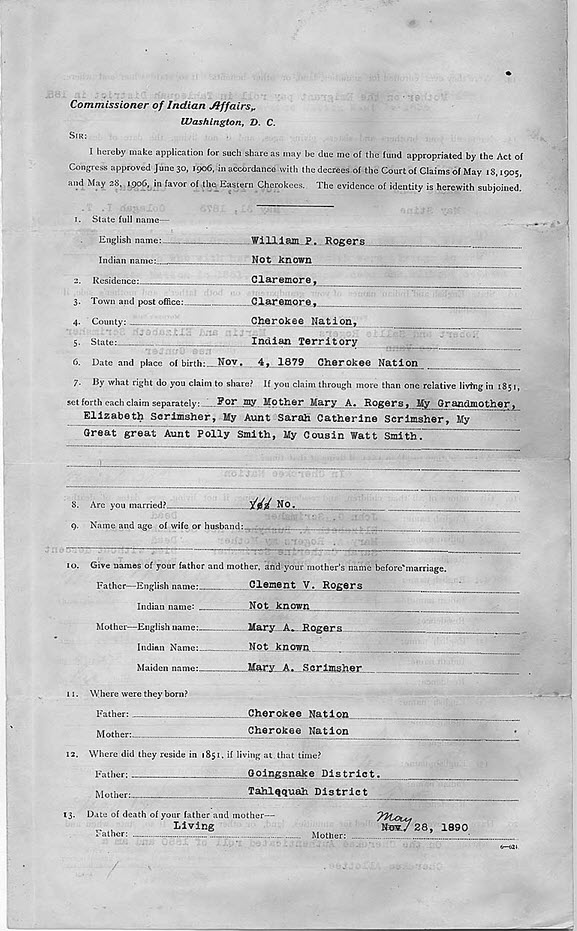

Guion Miller Roll, 1906–1911"Eastern Cherokee Applications" |
In 1902, Congress authorized the U.S. Court of Claims to hear claims arising from Cherokee treaties (32 Stat. 726). Three claims were filed under this act by the Eastern Cherokee and their descendants, alleging that the U.S. government had violated the Cherokee treaties of 1835 and 1846. The Court consolidated the cases and ultimately ruled in favor of the Eastern Cherokee on May 18, 1905.
This resulted in the appropriation of more than $1 million for the Tribe’s eligible individuals and families. Interior Department Special Commissioner Guion Miller created a list using several rolls and applications to verify tribal enrollment for the distribution of funds.
Application Process
To be approved for a share in the funds awarded to the Eastern Cherokee, an applicant had to:
- be alive as of May 28, 1906;
- establish that they were a member or descendant of a person who had been included in the forced removal to Indian Territory, known as the “Ross Party”;
- not be affiliated with a tribe other than the Cherokee; and
- submit an application that was received by August 31, 1907.
There was no residency requirement, and applicants came from across the United States and from abroad. Because there was a cash award, many people applied regardless of their eligibility.
Parents or guardians were given the opportunity to apply for minors and other dependents. Most of these applications were rejected due to late receipt; however, all contain important individual and family history information.
The applications document over 125,000 individuals. An application can include the applicant's:
- English and Indian names
- Date and place of birth
- Residence
- Spouse's name and children's names
- Siblings' names and ages
- Parents' and grandparents' places of birth and dates of death
- Names of extended family
The court ultimately approved 30,820 individuals to share in the funds; 3,436 resided east and 27,384 resided west of the Mississippi River.
How to Access the Records
The Guion Miller Roll and related applications (often called "Eastern Cherokee applications") are microfilmed, and the microfilm is digitized in the National Archives Catalog. Select the National Archives Identifiers below to view the digitized records.
-
M1104, Eastern Cherokee Applications of the U.S. Court of Claims, 1906–1909 (National Archives Identifier 301643)
- A digitized name index to the applications is available; see National Archives Identifier 300330.
- M685, Records Relating to Enrollment of Eastern Cherokee by Guion Miller, 1908–1910 (National Archives Identifier 300329)
- This publication includes the final roll, testimony of witnesses, and copies of earlier census rolls used to make the final determinations.
- The History Hub blog "'Special Reports' in the Guion Miller Roll Records" (2023) provides more information about Miller's reports on applications.
The Guion Miller Roll is also available online through Fold3.com (database titled "Guion Miller Roll ") and Ancestry.com (database titled "U.S., Records Related to Enrollment of Eastern Cherokee by Guion Miller, 1908–1910 "). Additionally, Fold3.com features the applications (database titled "Eastern Cherokee Applications "). The databases on both sites are searchable by name, date, place, and keyword.
How to Order Copies
Submit NATF Form 83 to order a copy of an Eastern Cherokee application. For more information about placing an order, see How to Obtain Copies of Records.
Related Records
-
M1773, Eastern Cherokee Census Rolls, 1835–1884 (National Archives Identifier 2110769)
-
"Eastern Cherokee Census Rolls, 1835–1884" (History Hub blog post)
PDF files require the free Adobe Reader.
More information on Adobe Acrobat PDF files is available on our Accessibility page.

